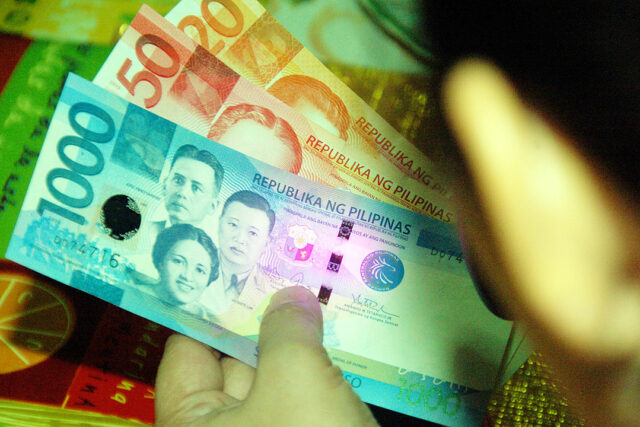Balisacan downplays currency fall

Diego Gabriel C. Robles
THE COUNTRY’S Socioeconomic Planning chief on Monday belittled the peso’s free fall against the dollar, saying there is nothing to worry about.
“It’s not something that we need to worry much [about] because we still have to see how that depreciation relates with our neighbors, with our competitors and with our economic fundamentals,” Socioeconomic Planning Secretary Arsenio M. Balisacan told reporters.
The peso closed at P55.08 on Monday, a centavo stronger than its near-17-year low on Friday.
Mr. Balisacan said he “completely agrees” with central bank Governor Felipe M. Medalla, who had also dismissed the peso’s depreciation.
“I would not question the wisdom of our Bangko Sentral ng Pilipinas (BSP),” he said. “They’ve been closely watching the market and adjusting in ways that would be appropriate for our case.”
Last week, the BSP governor did say they might consider a more aggressive rate hike at their Aug. 18 meeting if consumer prices continue to spiral out of control.
“One thing is clear: In the experiences of many countries, if you are deviating for a prolonged time and much from market fundamentals, then we are likely going to suffer the consequences,” Mr. Balisacan said. “Now, we don’t think that we are at that point.”
He noted that keeping local interest rates low despite persistently high rates globally could lead to capital flight. “When that happens, it affects all other variables like our exchange rate and inflation.”
The central bank needs a balancing act, Mr. Balisacan said. “The strategy of the BSP is to adjust with the global market situation, and adjust in a way that is also appropriate for us because we have to look at other variables like inflation.”
Inflation probably hit 6% in June amid spiraling oil and food prices and higher electricity rates, according to a median estimate of 16 analysts in a BusinessWorld poll last week, boosting the case for bigger increases in key interest rates.
This would be the quickest since 6.1% in November 2018, and faster than 5.4% in May and 3.7% in June last year, according to data from the Bangko Sentral ng Pilipinas (BSP). It would also breach the central bank’s 2-4% target and the Development Budget Coordination Committee’s (DBCC) 3.7-4.7% estimate this year.
Record gasoline prices paired with unrelenting food and commodity costs are adding a strain to Filipinos’ cost of living, suggesting that the BSP might have to increase rates further to slow economic growth.
The Philippine Statistics Authority (PSA) will release June consumer price index (CPI) data on Tuesday (July 5).
Crude oil prices have spiraled out of control amid concerns over supply since Russia invaded Ukraine on Feb. 24.
Gasoline, diesel and kerosene prices had jumped by P30, P45.90 and P39.75 a liter as of June 28, according to data from the Energy department.
The Monetary Board at its June 23 meeting raised the key rate by 25 basis points to 2.5%. The BSP is prepared to “take all necessary policy action to bring inflation toward a target consistent path over the medium term and deliver on its primary mandate of price stability,” former central bank governor and now Finance Secretary Benjamin E. Diokno said then.
The central bank also raised its average inflation forecast for this year to 5% from 4.6% and to 4.2% from 3.9% for next year. The average inflation is expected to slow to 3.3% by 2024.
The BSP will hold its next policy review on Aug. 18.
OUTPUT GROWTH
Meanwhile, Mr. Balisacan said he expects the economy to grow by more than 6% this year, days before economic managers review macroeconomic forecasts.
“We’re expecting a little above 6% for this year,” he said. “Our priority is to recover quickly from the pandemic and go back to the high-growth trajectory, mindful that we would want to make that growth more inclusive and more resilient.”
This would ensure that “the next time we have pandemics like this [or] any disruptions, technological or global, the economy should not be sharply affected,” he added.
The DBCC, which in May projected growth of 7-8% this year — well above Mr. Balisacan’s estimates — will review macroeconomic estimates on Friday.
Mr. Balisacan said the government of President Ferdinand R. Marcos, Jr. would try to revive job creation and poverty reduction, while addressing government debt and rising inflation.
Despite headwinds in the near term, “we are targeting, for the entire duration of the administration, while that is not officially set yet by the [DBCC], 6.5% to 8% [growth],” Mr. Balisacan said.
The DBCC is composed of the Budget and Finance departments, National Economic and Development Authority (NEDA) which Mr. Baliscan heads, and the Office of the President. It approves macroeconomic targets including revenue projections, the borrowing and budget levels, and spending priorities.
“Understandably, we may need to revisit the targets given the setbacks caused by the pandemic,” Mr. Balisacan said in a speech at the NEDA turnover ceremony on Monday.
“Nonetheless, the aspirations and vision remain relevant, guiding us to stay the course toward improving the welfare of Filipinos,” he added.
He noted that 7% to 8% is “spectacular” in itself, and it is “even more spectacular” if it comes with improved inclusive growth.
“Particularly significant to me is the Philippines being on investors’ radars and climbing the ranks based on globally recognized comparative indicators in economic performance and institutions, technology, preparedness and fundamentals such as ease of doing business.”
